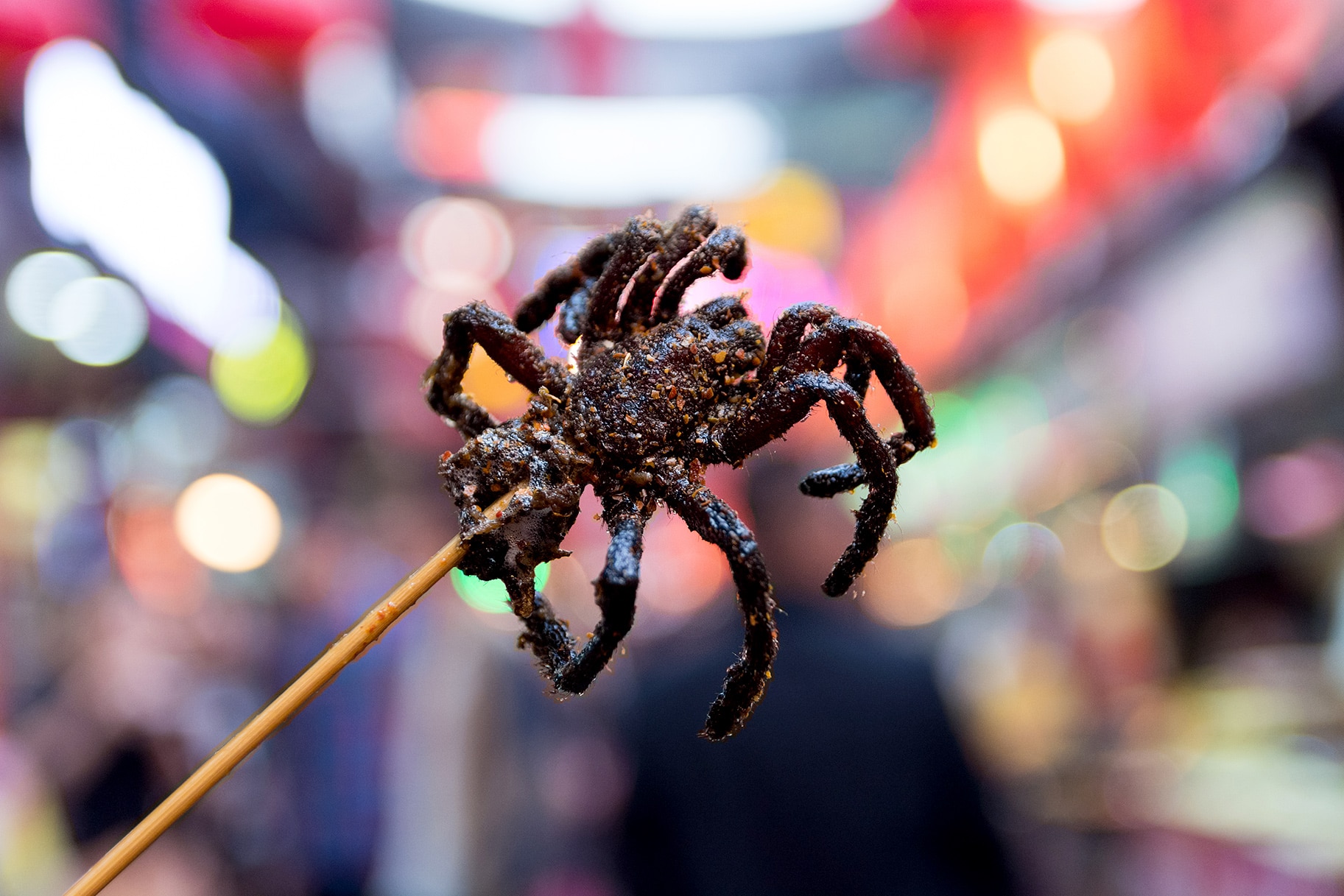
Create a free profile to get unlimited access to exclusive videos, sweepstakes, and more!
The 9 Scariest-Looking Foods in the World That Supposedly Taste Delicious, Too
Don't worry, these spiders won't bite.

The dinner table isn’t exactly a haunted house, but that doesn’t mean food can’t be terrifying to look at. Some fruit, such as rambutan, is so brightly colored and covered in spikes that it’s visually shocking, while other foods—think fried spiders—simply look too much like themselves. And then there’s movement. When dinner creeps and crawls on the plate, it’s bound to freak out even the most adventurous eaters. If you’re looking for a fright—or want to know which foods to avoid—we’ve scoured the globe for the world’s scariest-looking edibles, including one that can even kill you. Read on and be prepared to cover your eyes (but not your mouths).
1. Uni
Uni, or sea urchin, won’t always send shivers down your spine, but it certainly can. The edible part is the sea urchin’s gonads ,and while they do resemble slimy orange tongues, the effect is really more creepy than scary. It’s only when uni is served in its shell that it has the power to strike fear in diners and that’s because the shell is covered in sharp black spikes—and sometimes those spikes are still moving. Looks, of course, can be deceiving. Underneath its tough exterior, uni is rich and buttery, wonderfully sweet, and lightly briny.
2. Century Eggs
China’s beloved century eggs frighten simply because they look so starkly different from regular eggs: The yolks are dark green, while the whites are deep translucent amber. And if their appearance doesn’t scare you off, century eggs—also called hundred-year eggs, thousand-year eggs, or millennium eggs—reek of ammonia. In a process said to date back to the Ming Dynasty, chicken, duck, or quail eggs are cured in a salt mixture for weeks or even months, which turns the yolks creamy and custard-like and the whites gelatinous. As for flavor, century eggs are said to taste like hard-boiled eggs on steroids.
3. Fried Spiders
The arachnophobic will struggle the most with this one, but we’re willing to bet that fried spider would scare the bejesus out of just about anyone. Legend has it that this crispy treat dates back to the 1970s, when Cambodians, starving under the rule of the Khmer Rouge, resorted to eating fried tarantulas. Also known as a-Ping, fried spiders remain popular in Cambodia—some even consider them a beauty food. The eight-legged creatures are typically fried with sugar, spices, garlic, and salt. The squeamish are advised to stick to more brittle bugs, as those with squishy abdomens are deemed particularly icky.
4. Geoduck
It might be a stretch to call them scary, but with their not-so-subtly phallic appearance and the way they always seem to be bursting out of their shells, geoduck—pronounced “gooey duck”—are mighty unsettling. Native to the Pacific Northwest, geoduck is mostly a local specialty, though it’s also prized throughout Asia, and especially in China, where it’s considered an aphrodisiac. If you can get past the aesthetics, geoduck is delicately crunchy with a sweet, clean flavor that tastes of the sea.
5. Rambutan
With its brightly hued and dramatically spiky exterior, rambutan has an otherworldly quality that could easily alarm the uninitiated. The good news is that there’s little to fear. Those spindly bristles are actually quite soft and flexible, plus it’s easy to peel rambutan. And once you do, the smooth white fruit is tender, sweet, and tart; it’s often compared to lychee, but with a more acidic flavor. Rambutan is indigenous to Southeast Asia and popular in that region, but it can be found stateside in specialty markets and Chinatown produce shops.
6. Casu Marzu
Illegal in the United States and difficult to find outside Sardinia, where it’s made, Casu Marzu is a sheep’s milk cheese that’s fermented until it’s soft, wet, and—hold on to your hats—covered with live maggots. While some folks wipe off the creepy crawlers before digging in, others—gulp—do not. Flavor-wise, Casu Marzu is often compared to Gorgonzola, but you might not want to think about that too much, as at least some of the taste comes from maggot excrement. Yum.
7. Sannakji
Sannakji, a Korean specialty made of baby octopus, sounds tame, but the live young cephalopods are chopped and served so quickly that they continue to squirm and wiggle on the plate. If that doesn’t sufficiently scare you, keep in mind that consuming sannakji can be lethal. The octopus’ suction cups still have the power to grip, and each year, several people die from choking. Brave diners should be sure to chew thoroughly, which shouldn’t be too difficult, as sannakji is mild in flavor and typically paired with sesame oil or chili paste.
8. Huitlacoche
If huitlacoche’s bulbous blue-gray appearance doesn’t terrify you, one of its aliases—corn smut, devil’s corn, or raven’s poop—will surely turn you off. Huitlacoche is actually a disease that grows on ears of corn, forming spongy clouds that give the kernels a distinctly rotten look. Though many farmers destroy infected crops, huitlacoche is prized in Mexico, where its consumption dates back at least to the Aztecs. Increasingly popular with chefs both north and south of the border, huitlacoche is soft and spreadable with an earthy, slightly sweet flavor that works wonders in soups, sauces, tacos, tamales, and quesadillas.
9. Balut
Balut, a Filipino specialty, looks innocent from the outside, but once you crack the shell, prepared to be shocked. A duck egg that’s fertilized and allowed to develop for 16 to 20 days before being hard-boiled, balut contains a partially formed duck fetus—eyes, bones, feathers, and even a beak can all be part of the package. Balut also includes a soft and creamy yolk, a broth-like liquid, and a tough, bitter-tasting white that’s typically discarded. Though many find balut far too gruesome to consume, it’s hailed as a hangover cure and considered a natural form of Viagra.

























